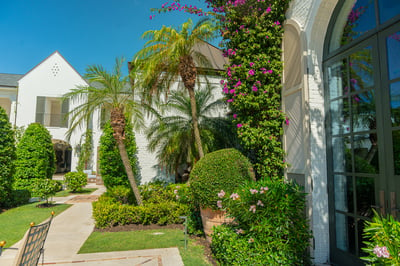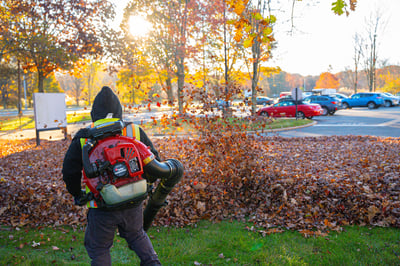We hope you’re as excited as we are about the warmer temperatures drifting in and seeing another summer on the horizon. And these warm temperatures should bring with them awe-inspiring growth to your property’s landscape.
But with the arrival of May, it’s important to follow some important, but simple steps to ensure a healthy landscape as the year rolls along. We’ve put together a May to-do list for you in this article, making it easier for you and your landscaping provider to keep your property pristine while staying ahead of problems that can sidetrack the beauty and health of your landscape.
Here’s what we’ll cover:
- Region-by-region pests and diseases to monitor
- Seasonal clean-up (did anything get missed?)
- New plantings and replacements
- Three issues that get overlooked in early summer
- Mowing (the right way)
- Weed and turf diseases
- Scheduling and communication
- Sustainable curb appeal
Pest & Disease Checks: Regional Focus
Chinch bugs are a serious threat to commercial landscapes, and not just in Florida. May is a good time for property owners in transition regions to watch for turf damage (in open areas typically). March through November (depending on the region) is the most active time for these harmful insects.
Chinch bugs start slowly but can gain momentum, with infestations of 150 - 200 harmful pests per square foot of turf!
What about other landscape pests around the U.S.?
- Southeast: Aphids and fire ants
- Midwest: Billbugs and armyworms
- Southwest: Bark beetles and cutworms
- Northeast: Japanese beetles and sod webworms
Integrated pest management (IPM) and plant health care (PHC) strategies are year-round solutions that fight landscape pests while helping you stay ahead of the following diseases:
- Dollar spot in the West
- Red thread in the Northeast
- Brown patch in the Southeast
- Summer patch in the Midwest
Seasonal Clean-up Concerns
Another item property owners might need to address are seasonal clean-up tasks that got overlooked in the spring. Are there fallen limbs in hidden spots of the property in need of removal? Leaves clogging up a drain?
A responsible landscape provider will be glad you pointed out any missed clean-up details so they can address it immediately with their crews before they get too deep into the summer mowing season. Also, when you notice any missed spring clean-up items, it can help you plan out your next seasonal clean-up.
Three common items to check off that aren’t specifically about landscaping, but are important and often overlooked:
- Clean water features and check pumps and filters
- Power wash walkways, patios, and other hardscaping
- Clean and inspect outdoor furniture for damage
Yellowstone Landscape believes in comprehensive landscape maintenance, which includes systematic seasonal clean-ups. Our teams get in-depth training and numerous educational opportunities. This assures healthy, thriving landscapes that elevate your curb appeal.
May Planting & Replacement To-do Tasks
May is bursting with life in outdoor spaces. This time of year is ideal for installing new annuals and perennials. Why?
The soil’s warming up. This warming stage creates a near-perfect environment for strong root growth for plants, shrubs, trees, and turf. Newly planted trees and shrubs establish roots best before soil temps exceed 75°F.
May’s warmer weather and soil conditions mean it’s prime time to replace trees or shrubs that have succumbed to winter damage. And to maximize your property’s landscaping budget, focus on entrances, signage, and your most popular amenities. This to-do list item ensures the most visible sections look their best as summer heats up and more people are out and about across your property.
When your commercial landscape provider uses the “right plant, right place” philosophy, your budget benefits once again. Your plants will live longer, while requiring fewer resources and less labor.
Need a quick reminder of the right plant, right place philosophy again?
- Match plants to ideal sun, shade, and soil type
- Choose native plants when possible
- Select pest- and disease-resistant species
- Avoid planting heat-sensitive plants in May (summer heat stress is a threat)
- Proper plant grouping saves water, fertilizer, and benefits the entire landscape
What’s one crucial concern you don’t want to worry about as summer heat ramps up? Irrigation problems. Check this off your list ASAP. As temperatures rise, your turf and plants could become more dependent on moisture via irrigation when dry weather settles in.
Be prepared. Check your landscape contract or contact your service provider about the following:
- Do they perform regular water audits (leak inspection, coverage concerns, and sprinkler head checks)?
- Have they adjusted scheduled watering for May’s changing weather?
- Does your irrigation company offer water pressure testing (to avoid damage and find hidden leaks)?
And if your irrigation system is several years old, consider upgrading to a smart irrigation system. It will pay for itself before long because you could be wasting hundreds of gallons of water per month—or every week!
Certifications
Yellowstone Landscape’s irrigation managers are certified in the latest smart water best practices. We must adhere to sustainability goals—ours and our clients’. Plus, why not offer options that save our customers money on water bills?
The simplest way to prepare for common summer landscape problems in May? Add a mulch check to your to-do list (tips below).
- Mulch should be 2-3 inches deep
- Refresh mulch that has faded due to heavy sun exposure
- Avoid mulch volcanoes that make plants vulnerable to pests and disease
You also want to be certain your landscape professional has done a recent soil test to inform the correct fertilizer formula. Your property’s soil type could vary from one section to the next, too. A detailed fertilization program is a must for keeping your landscaping attractive in early summer and beyond.
Mowing Season in Full Swing
Lawn mowing may seem mundane, and the details not super-critical. Yet, this “mundane” task is crucial, especially in May.
First, your commercial property’s grass will begin growing much faster in early May (depending on grass type and regional temps). Consistent mowing encourages lush, colorful, and healthy turf.
Proper mowing practices also prevent the following negative outcomes:
- Scalping
- Thatch buildup
- Weed growth in neglected areas
- Clippings landing in landscape beds
- Clumps of clippings may smother the grass
- Poor turf health from cutting too much at once
- Uneven appearance with patchy, overgrown areas
The Finer Details
Well-trained crews should understand mower blades must be sharpened every eight to ten hours of use. And the most they should cut off the top of grass blades is one-third of an inch. Experienced service crew team members will be observing the following mowing heights:
- Bermuda: 1–2 inches
- Fescue: 2.5–3.5 inches
- St. Augustine: 3–4 inches
- Kentucky Bluegrass: 2–3 inches
What about mowing during summer droughts? Our trained professionals know to mow at increased heights to avoid stressing the turf further.

Turf Disease & Weed Vigilance
There’s no question weeds and disease are on the hunt for unhealthy lawns because they’re easy targets. The earlier turf diseases are spotted, the better the chance of ridding your landscape of them. And when it comes to weeds, a comprehensive weed management program is your landscape’s best defense.
Let’s look at a couple of different signs of turf diseases. Silver dollar-sized patches indicate possible dollar spot disease. Circular brown spots with lighter-colored outer rings might indicate brown patch disease. And the key to solving both is early detection.
What about disease prevention? Regular mowing and dethatching go a long way in preventing lawn diseases in the first place. The same goes for aeration due to improved air and water penetration into the soil. And an easy way to keep diseases at bay? Keep an eye on your irrigation schedule to avoid overwatering and underwatering.
Are there times when environmental conditions make disease control difficult? Of course, there are. That’s when fungicides may be needed to avoid diseases spreading. Your provider should be licensed and expertly trained on proper fungicide use and follow all locally required environmental guidelines.
And remember that a comprehensive landscape maintenance program reduces the need for fungicides.
The same is true for weed control of the following weeds, too.
- West: Spurge and oxalis
- Midwest: Nutsedge and foxtail
- Northeast: Dandelion and clover
- Southwest: Goosegrass and purslane
- Southeast: Crabgrass and dollarweed
In each region, weeds can be minimized by keeping turf healthy and resilient through proper irrigation, mowing, fertilization, and monitoring. Pre-emergent herbicides in early spring deter problematic weed growth when the growing season ramps up.
As May’s showers and warmer temperatures arrive, any visible weeds should be spot-treated.
Why’s it important to stay well ahead of lawn weeds? They multiply at scale. A dandelion, for instance, can produce up to 15,000 seeds in a single season. A proven service schedule is vital, as we’ll cover more in the next section.
Scheduling & Communication: A Closer Look
One thing we focus on intently in our internal company trainings is communication. So our Yellowstone Landscape branch managers often hear from customers how they appreciate our communication concerning both our service delivery and scheduling. Both parties, vendor and client, should be on the same page when it comes to what we’re doing and when we’ll be doing it.
Here are some best practices to help if your provider’s communication isn’t where you’d like it to be:
- Review all provided maintenance schedules regularly
- Discuss planned enhancements ahead of time to install them
- Use a shared digital calendar with your provider
- Comb through the landscape contract before it renews to adjust terms as needed
- Discuss ideal times for certain services to avoid disturbing residents during busy hours
- Design a system for alerting residents and staff about service dates (texts, emails, flyers, etc.)
When More Communication is Needed
Extra communication isn’t only needed for major landscaping projects, it’s vitally important for seasonal changes, too.
Additional communication helps prevent confusion. It also reduces complaints from your residents and staff when they’re kept in the loop. For example, residents or staff might want to move their vehicles during leaf clean-ups to avoid dust landing on their freshly cleaned cars.
At Yellowstone Landscape, we’ve found the closer we’re connected to the community, the better the communication. That’s why our local branch managers often sit in on our customers’ HOA meetings, facility managers' meetings, and council sessions.
Enhancing Curb Appeal & Sustainability
We feel that enhancing curb appeal and improving sustainability initiatives should be a year-round priority. However, these two items are perfect additions for May’s landscaping to-do list. The weather conditions are ideal in most parts of the country—so the timing’s right for enhancing sustainability features that also improve your property's visual appeal.
The following are terrific ways to boost curb appeal in May:
- Add seasonal color—focusing on entrances and high-traffic spots
- Use large planters or hanging baskets for a stand-out look
- Select blooms that match your business’ brand, community vibe, or holiday themes
- Ensure overgrown trees or shrubbery aren’t blocking views of blooming flowers
- Check outdoor lighting—for safety and to highlight landscape elements at night
Often Overlooked
The thing many people miss about sustainable landscaping is that it doesn't only protect the environment. It plays a big role in curb appeal and saves property owners money.
Sustainable landscaping requires less upkeep and fewer resources for plants to thrive (reduced water bills and less fertilizer). Native plants can help your property stand out through unique textures, structures, and visual appeal through a tangible local feel.
Strategies like xeriscaping take sustainability to another level. Your entire landscape will draw attention through unique design, decorative rock, and plant selection. Plus, you’ll be prepared for droughts that may strike. And your xeriscapes’ low-water needs put you in a great position if water rates rise over the next several years.
Need more ways to enhance your sustainability goals while increasing curb appeal?
- Native grasses can reduce fertilizing and weed control costs
- Add pollinator plants to attract colorful butterflies and hummingbirds
- Consider low-maintenance groundcovers to reduce lawn mowing costs
- Invest in smart irrigation, so plants live longer and look their best with precise moisture levels
- Group plants with similar water needs together to save water and create complementary beds

Conclusion
It’s hard to imagine a better time of year to get outdoors than May. That’s why we gave you plenty of landscaping to-do tasks. They’re sure to help your property look its best as more people get outside and start to notice your property’s landscape.
Remember: Pests and diseases can quickly diminish your landscaping aesthetics. So, we discussed what to monitor and common insects and diseases in various regions. We also discussed seasonal clean-ups, plantings, and problems that pop up with May’s warming temperatures.
The list of landscaping to-do items for turf should keep your lawns lush and vibrant all summer. Simple tasks done right matter a lot—mowing, fertilizing, and watering.
Finally, we went deep into the details of sustainability, alongside curb appeal. Those insights give you action steps that can save you thousands of dollars over time. The bonus of sustainable landscaping? A noteworthy landscape that sets your property apart from cookie-cutter designs that aren’t sustainable.
If you want to discuss any concerns with your landscaping to-do list, contact Yellowstone Landscape for a consultation.






